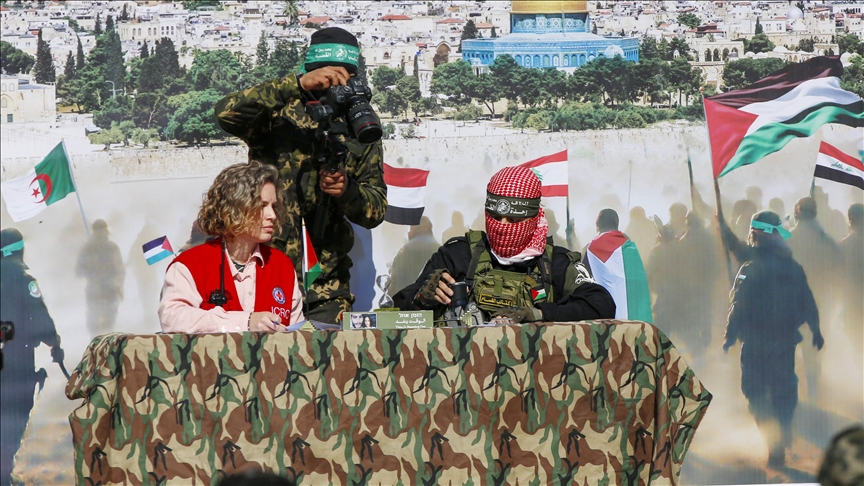Hamas Returns the Bodies of the Youngest Hostages from Israel Taken During the Gaza Conflict

On Thursday, Hamas returned the bodies of Israeli children Kfir Bibas, an infant, and his four-year-old brother Ariel. They were the youngest hostages taken during Hamas’s October 7, 2023 attack, and became powerful symbols of the suffering caused that day. Red Cross vehicles left the Gaza Strip after the handover, transporting four black coffins placed on a stage. Each coffin had a photo of the deceased children.
Hamas militants, dressed in black and camouflage uniforms, encircled the area.
Volker Turk, the United Nations human rights chief, condemned the display of bodies in Gaza, calling it both appalling and inhumane, and emphasized that it violated international law.
“According to international law, the handling of the remains of the deceased must adhere to the prohibition of cruel, inhuman, or degrading treatment, ensuring the dignity of both the deceased and their families is respected,” he stated in his remarks.
After the Red Cross handed over the hostages, the military reported that the coffins were inspected for explosives before being sent to Israel. Along the route near the Gaza border, Israelis stood in the rain to pay tribute as the convoy with the coffins passed by.
One woman, who identified herself only as Efrat, said, “We are here together with broken hearts. Even the sky is crying with us, and we hope for brighter days ahead.”
In Tel Aviv, people gathered in sorrow at what has come to be known as Hostages Square, outside Israel’s defence headquarters, many in tears.
President Isaac Herzog spoke for the nation, saying, “The pain and agony are beyond words. The hearts of an entire nation are in pieces.”
One militant stood beside a poster of a man standing over coffins wrapped in Israeli flags. Instead of legs he had tree roots in the ground, suggesting the land belongs to Palestinians. The poster read “The Return of the War=The Return of your Prisoners in Coffins”.
The two boys, their mother Shiri Bibas and a fourth hostage, Oded Lifschitz, were handed over under the Gaza ceasefire agreement reached last month with the backing of the United States and the mediation of Qatar and Egypt.
The Red Cross on Wednesday urged the handover be kept dignified. The Hamas-directed public hostage release ceremonies have come under growing criticism, including from the United Nations, which denounced the “parading of hostages”.
Kfir Bibas was only nine months old when his family, including his father Yarden, was kidnapped from Kibbutz Nir Oz, a community near Gaza that was attacked by Hamas militants. In November 2023, Hamas claimed that the boy and his mother were killed in an Israeli airstrike, but Israeli authorities never confirmed their deaths.
“Shiri and the kids became a symbol,” said Yiftach Cohen, a resident of Nir Oz, where around 25% of the population was either killed or taken hostage during the attack.
Yarden Bibas was released in a prisoner swap earlier this month. Among the Israelis who died on October 7 were also well-known peace activists.
Lifshitz, aged 83, was abducted from Nir Oz, the kibbutz he had helped to establish. His 85-year-old wife, Yocheved, was also captured but was released two weeks later, along with another woman.
A former journalist, Lifshitz wrote an opinion piece for the liberal-leaning Haaretz newspaper in January 2019, where he criticized Prime Minister Benjamin Netanyahu’s policies. Among his points was Netanyahu’s rejection of the two-state solution with the Palestinians, as well as his support for a 2011 prisoner swap that freed more than 1,000 Palestinian prisoners, including the extremist Yahya Sinwar, in exchange for an Israeli soldier.
Sinwar later became the leader of Hamas in Gaza and masterminded the October 7 attack. He was killed by Israeli forces during the Gaza conflict. Both Netanyahu and Israel’s defence leadership have been criticized for failing to prevent the security breach on October 7, which became the deadliest day in Israel’s history.
LIVING HOSTAGES
The handover of the bodies marks the first time under the current agreement that deceased individuals have been returned, but Israel is not expected to identify them until DNA tests are finalized. According to Israeli sources, Hamas’ attack on Israel resulted in around 1,200 deaths and 251 people being kidnapped. In response, Israel’s military actions have led to roughly 48,000 deaths, as reported by Palestinian health authorities, and caused widespread destruction in Gaza.
The body handover on Thursday will be followed by the release of six living hostages on Saturday, in exchange for hundreds of Palestinians, mostly women and children, who have been detained by Israeli forces during the conflict.
Talks for a second phase, which are anticipated to involve the return of around 60 remaining hostages—less than half of whom are thought to be alive—and a full withdrawal of Israeli troops from Gaza to bring an end to the war, are expected to start soon.
